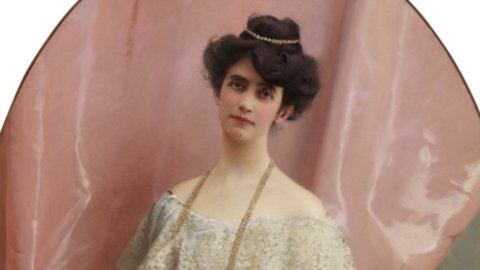From 6 September to 14 December 2014, Palazzo Zabarella in Padua will host an important anthology dedicated to VITTORIO CORCOS (Livorno 1859 – Florence 1933). The exhibition will trace the artistic career of the painter from Livorno through his most famous masterpieces, alongside numerous unpublished works .
The exhibition, curated by Ilaria Taddei, Fernando Mazzocca and Carlo Sisi, will retrace the story of the painter from Livorno - fifteen years after the retrospective held in his hometown - presenting a considerable core of masterpieces, alongside numerous unpublished works, from major museums Italian and French and from the major public and private collections, able to attest to the growing critical fortune of the artist, also documented by the frequent exhibition of his paintings in recent national initiatives.
The fame of Corcos was already notable in the first half of the last century. Ugo Ojetti, in 1933, was able to write: “Who does not know the painting of Vittorio Corcos? Careful, smooth, meticulous, optimistic: women and men as they wish to be, not as they are”, and Cipriano Efisio Oppo, in 1948, “A clear, sweet, smooth, well-finished painting: silk, silk, straw, straw, wood, wood, and shiny copal shoes, shiny like only I can do them, said Corcos”.
The itinerary will revolve around the painting Dreams exhibited at the Festa dell'Arte e dei Fiori, the international exhibition inaugurated in Florence in 1896 where the painting had aroused a "fiendish noise" and provoked a heated debate on the meaning to be attributed to that intense portrait of young woman, now defined as "spiritualist" now "realist", but finally universally admired for the originality of the composition and the restless character of the protagonist.
The visitor will also be able to admire some selected samples of French and Italian haute couture so as to enrich, with spectacular references to the costumes of the time, the social and artistic context within which Corcos found itself operating.
Born in Livorno and enrolled as a young man at the Academy of Fine Arts in Florence, Corcos chooses Naples as an alternative destination to his Tuscan training, meeting Domenico Morelli between 1878 and 1879 who convinced him to go to Paris where the artist will bond to the merchant Goupil – in which Boldini and De Nittis gravitated in those same years – and will inaugurate his brilliant and worldly vein in line with the aspirations of the French to celebrate every aspect of modern life. Frequent in the studio of Léon Bonnat, also frequented by Toulouse-Lautrec, Corcos presented his paintings at the Salons (A la brasserie; L'anniversaire); he applies himself to painting en plein air demonstrating, in small and precious landscapes, an intelligent updating on the developments of contemporary European art; does not fail to participate in the evenings of the De Nittis salon, artist and friend from whom he derives the atmospheric lightness of some of his urban and marine views as well as the grace of the female portraits that will make the international fortune of Corcos as an inimitable "peintre des jolies femmes" sought after by the beau monde at the end of the century but also by prestigious personalities of the first thirty years of the twentieth century.
In 1887, after having converted from the Jewish religion to the Catholic one, he married Emma Ciabatti, Rotigliano's widow, and settled permanently in Florence, which he would leave only for occasional business trips to London and Paris. In the atmosphere of Umbertine Italy, the subjects dealt with by Corcos (The morphine addict, Rupture, The two virgins) reflect, thanks to their engaging narration, the literary suggestions of naturalism and symbolism from beyond the Alps; while the intellectual acquaintances of his wife will introduce the artist into the cenacle of the 'Marzocco', the newspaper that operated amidst the solemn decline of Carducci, the intimate observatory of Pascoli's 'young boy', the sumptuous workshop of Gabriele d'Annunzio.
The Corcos catalog does not lack paintings inspired by life in the fields, declined in a style that included scenes of rustic life, joyful or melancholy, set in wide-ranging natural scenarios, also studied on the equally popular French models of Millet and Breton. in Tuscany, by his painter friends Cannicci, Gioli, Tommasi, Cecconi, Signorini. In addition to being the author of a famous portrait of Carducci, an assiduous visitor to the family literary salon, Corcos was the author of official retrospective portraits (Giuseppe Garibaldi), of intense snapshots of contemporary characters (Mascagni, Yorik, Lega, Puccini), of elegant icons of his time (Lina Cavalieri, Nerina Volpi di Misurata) but he was also called to very prestigious assignments, such as those relating to the portraits of Carlos and Amalia of Portugal (1904), of the emperor William II (1904), of Queen Margherita (1922) . On the sidelines of that successful activity, one can recall what Corcos himself declared regarding his method of representation: “In a portrait, what matters are the eyes; if they succeed as I want, with the right expression, the rest will follow by itself”.
Corcos' literary interests manifested themselves, hand in hand, in his collaboration with the 'Marzocco' and the 'Tribuna'; in a volume of short stories (Mademoiselle Le Prince, Livorno 1901); in his participation in the editorial projects of Pascoli (corresponding to his wife, whom the poet called the "unknown gentleman") who had associated him with Nomellini and De Carolis in the decorative planning of their volumes.
In 1913 Corcos will donate his self-portrait to the Uffizi Gallery.
VITTORIO CORCOS
Padua, Palazzo Zabarella (via San Francesco 27)
6 September - 14 December 2014





